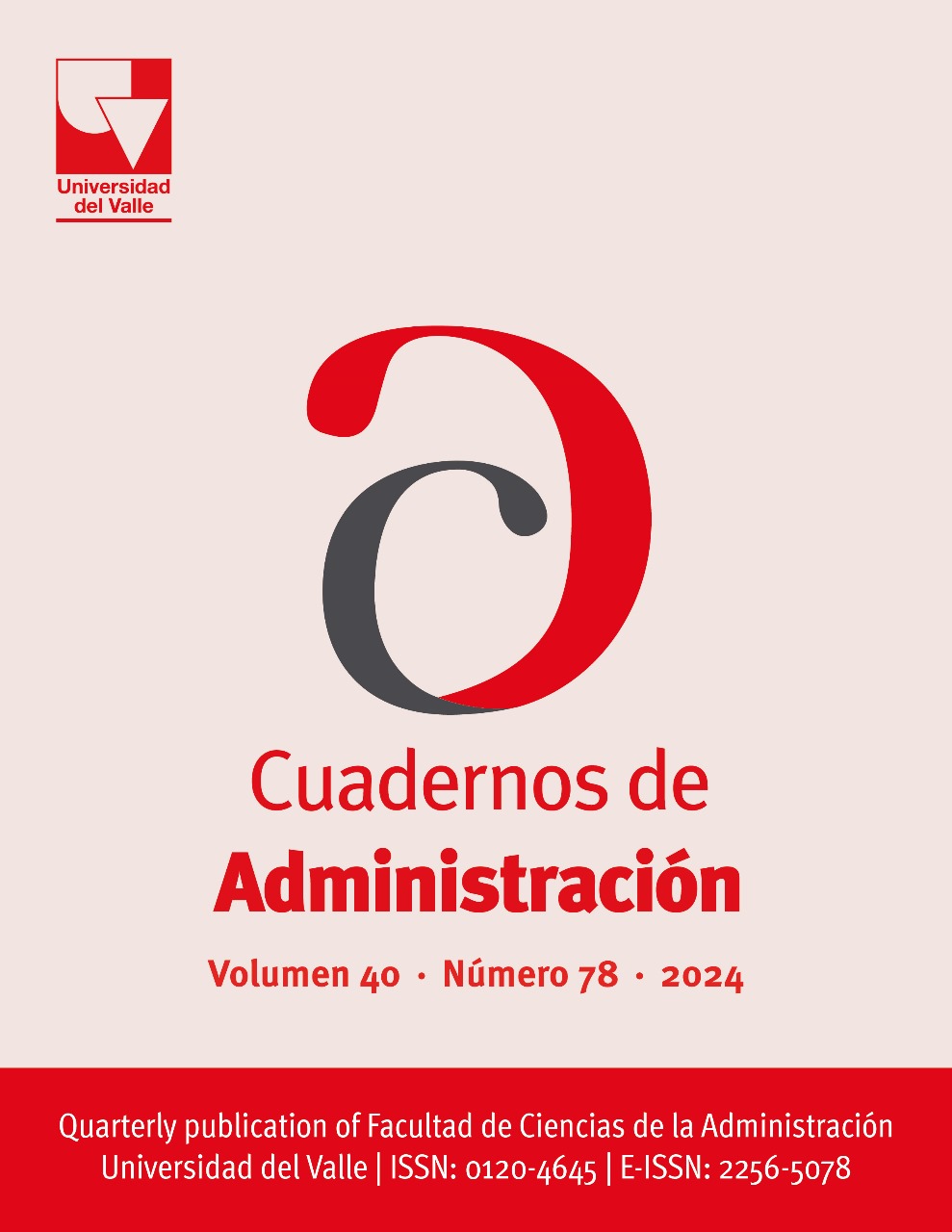Technical efficiency in secondary education and health for developed and developing countries: an estimate for 2018
Main Article Content
This paper employs a two-stage Data Envelopment Analysis (DEA) to estimate technical efficiency in secondary education and health for 59 and 73 countries, respectively, using data from 2018. The analysis tackles important issues, such as the incidence of outliers and the incorporation of non-discretionary variables. Although other papers use monetary figures (e.g., expenditures) as inputs due to the difficulty of accessing physical units, we avoid this practice due to the risk it entails, such as neglecting the incidence of different cost structures in the outcomes associated with the implementation of financial resources; additionally, there are relatively few publications on efficiency that include more than one sector. According to the study, the technical output-oriented efficiency in the health sector is higher than in the education sector, with efficiency indices of 0.995 and 0.887, respectively. Likewise, it is observed that the countries that obtain greater output quantities are also the most efficient in each sector, not necessarily those that use fewer inputs.
- Technical efficiency
- DEA
- Education efficiency
- Health efficiency
- Corruption
Afonso, A., Aubyn, M. (2005). Non-Parametric Approaches to Education and Health Efficiency in OECD Countries. Journal of Applied Economics, 8(2), 227–246. https://doi.org/10.1080/15140326.2005.12040626 DOI: https://doi.org/10.1080/15140326.2005.12040626
Afonso, A., Aubyn, M. S. (2006). Cross-country efficiency of secondary education provision: A semi-parametric analysis with non-discretionary inputs. Economic Modelling, 23(3), 476-491. https://doi.org/10.1016/j.econmod.2006.02.003 DOI: https://doi.org/10.1016/j.econmod.2006.02.003
Afonso, A., Schuknecht, L., & Tanzi, V. (2005). Public sector efficiency: An international comparison. Public Choice, 123, 321–347. https://doi.org/10.1007/s11127-005-7165-2 DOI: https://doi.org/10.1007/s11127-005-7165-2
Álvarez, A. (2013). La medición de la eficiencia y la productividad. Ediciones Pirámides.
Arias-Ciro, J., Torres-García, A. (2018). Economic efficiency of public secondary education expenditure: How different are developed and developing countries? Revista Desarrollo y Sociedad, 80, 119-154. https://doi.org/10.13043/DYS.80.4 DOI: https://doi.org/10.13043/DYS.80.4
Aristovnik, A., Obadić, A. (2014). Measuring relative efficiency of secondary education in selected EU and OECD countries: the case of Slovenia and Croatia. Technological and Economic Development of Economy, 20(3), 419-433. https://doi.org/10.3846/20294913.2014.880085 DOI: https://doi.org/10.3846/20294913.2014.880085
Besley, T., Persson, T. (2013). Taxation and development (pp. 51-110). In A. Auerbach, R. Chetty, M. Feldstein, & E. Saez (Eds.), Handbook of Public Economics. https://doi.org/10.1016/B978-0-444-53759-1.00002-9 DOI: https://doi.org/10.1016/B978-0-444-53759-1.00002-9
Carrillo, M., Jorge, J. M. (2017). DEA-Like Efficiency Ranking of Regional Health Systems in Spain. Social Indicators Research, 133, 1133–1149. https://doi.org/10.1007/s11205-016-1398-y DOI: https://doi.org/10.1007/s11205-016-1398-y
Castañeda-Rodríguez, V. (2011). Reflexión acerca de la representación del agente en la teoría económica evolutiva: controversia entre las perspectivas ortodoxa y heterodoxa. Cuadernos de Economía, 30(55), 31-53. https://revistas.unal.edu.co/index.php/ceconomia/article/view/28210
Charnes, A., Cooper, W., & Rhodes, E. (1978). Measuring the Efficiency of Decision-Making Units. European Journal of Operational Research, 2(6), 429-444. https://doi.org/10.1016/0377-2217(78)90138-8 DOI: https://doi.org/10.1016/0377-2217(78)90138-8
Cylus, J., Papanicolas, I., & Smith, P. C. (Eds.). (2016). Health System Efficiency: How to Make Measurement Matter for Policy and Management. World Health Organization. https://iris.who.int/bitstream/handle/10665/326305/9789289050418-eng.pdf?isAllowed=y&sequence=1
ECLAC. (2022). Fiscal Panorama of Latin America and the Caribbean 2022: Fiscal policy challenges for sustainable and inclusive development. United Nations. https://repositorio.cepal.org/server/api/core/bitstreams/a4d6289a-f2b7-4446-b3ed-a4d3371a9c7a/content
Gavurova, B., Kocisova, K., Belas, L., & Krajcik, V. (2017). Relative efficiency of government expenditure on secondary education. Journal of International Studies, 10(2), 329-343. https://doi.org/10.14254/2071-8330.2017/10-2/23 DOI: https://doi.org/10.14254/2071-8330.2017/10-2/23
Haini, H. (2020). Spatial spillover effects of public health and education expenditures on economic growth: evidence from China’s provinces. Post-Communist Economies, 32(8), 1111-1128. https://doi.org/10.1080/14631377.2020.1722586 DOI: https://doi.org/10.1080/14631377.2020.1722586
Izquierdo, A., Pessino, C., y Vuletin, G. (2018). Mejor Gasto para Mejores Vidas: Cómo América Latina y el Caribe Puede Hacer Más con Menos. Banco Interamericano de Desarrollo. https://doi.org/10.18235/0001217-es DOI: https://doi.org/10.18235/0001217-es
Mandl, U., Dierx, A., & Ilzkovitz, F. (2008). The effectiveness and efficiency of public spending. European Communities. http://ec.europa.eu/economy_finance/publications
Nguyen, T., Bach, T., Le, T., & Le, C. (2017). Local governance, corruption, and public service quality: evidence from a national survey in Vietnam. International Journal of Public Sector Management, 30(2), 137-153. https://doi.org/10.1108/IJPSM-08-2016-0128 DOI: https://doi.org/10.1108/IJPSM-08-2016-0128
Piabuo, S.M., Tieguhong, J.C. (2017). Health expenditure and economic growth - a review of the literature and an analysis between the economic community for central African states (CEMAC) and selected African countries. Health Economics Review, 7(23), 1-13. https://doi.org/10.1186/s13561-017-0159-1 DOI: https://doi.org/10.1186/s13561-017-0159-1
Preston, S. (1976). Mortality Patterns in National Populations. Academic Press. https://www.sciencedirect.com/book/9780125644501/mortality-patterns-in-national-populations
Rehm, J., Baliunas, D., Borges, G., Graham, K., Irving, H., Kehoe, T., Parry, C., Patra, J., Popova, S., Poznyak, V., Roerecke, M., Room, R., Samokhvalov, A., & Taylor, B. (2010). The relation between different dimensions of alcohol consumption and burden of disease: an overview. Addiction, 105(5), 817-43. https://doi.org/10.1111/j.1360-0443.2010.02899.x DOI: https://doi.org/10.1111/j.1360-0443.2010.02899.x
Sickles, R., Zelenyuk, V. (2019). Measurement of Productivity and Efficiency: Theory and Practice. Cambridge University Press. https://doi.org/10.1017/9781139565981 DOI: https://doi.org/10.1017/9781139565981
Simar, L., Wilson, P. (2007). Estimation and inference in two-stage, semi-parametric models of production process. Journal of Econometrics, 136, 31-64. https://doi.org/10.1016/j.jeconom.2005.07.009 DOI: https://doi.org/10.1016/j.jeconom.2005.07.009
Tanzi, V., Davoodi, H. (1997). Corruption, public investment, and growth. Working paper 97(139). International Monetary Fund. https://www.imf.org/external/pubs/ft/wp/wp97139.pdf DOI: https://doi.org/10.5089/9781451929515.001
Volkan, R., Serdal, B. (2016). Measuring the efficiency of health systems of OECD countries by data envelopment analysis. Applied Economics, 48(37), 3497-3507. https://doi.org/10.1080/00036846.2016.1139682 DOI: https://doi.org/10.1080/00036846.2016.1139682
World Health Organization. (2019). Global Status Report on Alcohol and Health 2018. World Health Organization. https://www.who.int/publications/i/item/9789241565639
Downloads

This work is licensed under a Creative Commons Attribution-NonCommercial-NoDerivatives 4.0 International License.





